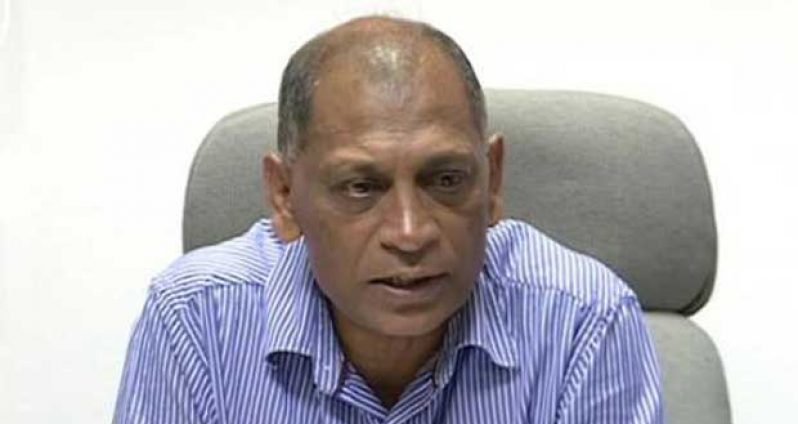THE promotion of soil health is to be a major priority of the Ministry of Agriculture over the next seven years. At the recent launch of the ministry’s strategy 2013-2020, strengthening of soil health as an important part of increasing productivity and quality was identified among 25 priority areas.
These are the areas the Ministry will focus on as it moves towards realising a 2020 vision of agriculture becoming a national facilitator for food and nutrition security, economic opportunities and for environmental sustainability.
The focus on soil health will be on promoting prudent utilisation of biological, chemical and physical methods in an eco-system agronomic approach that allows for the pursuit of agriculture in a sustainable manner whilst at the same time protecting the soil and the environment, Minister of Agriculture Dr. Leslie Ramsammy said.
“We are well aware that 33 percent of the global soil is now regarded as degradable and could no longer support agriculture, and 33 percent of the soil being used today in agriculture globally are also vulnerable for degradation. We want to practice agriculture in a safe way, in a safe environment so that it does not create harm to our people, but also preserves the integrity of our soil and water,” Minister Ramsammy said.
He explained that maintenance of soil health through improved soil fertility management (improved soil nutrient and pest management practices) will be ensured through research at the National Agricultural Research and Extension Institute (NAREI.) Focus will also be on ensuring the implementation of an affordable and practical Integrated Soil Management ( ISM) programme that will not only emphasise the management of nutrient flows, but also other important aspects of soil health, such as maintaining organic matter content, soil structure and soil biodiversity.
In this regard, a programme for Site-Specific Nutrient Management will also be introduced and a GIS Map for soils developed for long-term usage.
The Ministry will also focus on encouraging local farmers to pay close attention to the biological activity of microbes and macro-fauna that contribute to healthy soil, even as it seeks to educate farmers into taking into consideration the complex interaction between environmental factors, such as temperature, moisture, acidity and the chemical components of soil and biological activity.
To this end, there will be the development of training and awareness programmes and the introduction of new technologies and techniques to address biological inputs, organic matter inputs, inorganic matter inputs, tillage and use of pesticides.
Every agriculture extension worker and farmer is set to benefit from these awareness and training programmes.
Minister Ramsammy noted that the sugar, rice and cash crop industries have already been investigated in the use of bio-fuel fertilisers towards reduced costs (purchase of fertilisers and chemicals), and also towards practicing agriculture that is safe and sustainable.
He noted that to support such a focus, especially for the laboratories, professionals in the field would be necessary, hence another priority focus of the ministry’s agriculture strategy 2013-2020 of accelerating agriculture development in Guyana by focusing on securing an agriculture workforce through human resources development.
In this regard, the Guyana School of Agriculture and the Agriculture Department of the University of Guyana will be elevated in prominence, the minister explained.
“The building of human resources through the Guyana School of Agriculture, the University of Guyana, the Port Mourant Training Centre, and the Technical Institutes of Guyana are critical as we mechanise agriculture in Guyana. We recognise the great difficulty that rice and sugar face for labour and need to reduce cost, we recognise the large scale production of corn and soya and other products will require mechanisation. How do we prepare our young people to work in an environment of greater mechanisation? These are the areas the strategy will focus on,” Minister Ramsammy said.
A curriculum review would be conducted at the GSA and the Agriculture Department of UG to ensure their programmes are in line with the Vision for Agriculture 2020.
Additionally, the curriculum review for the GSA will consider the introduction of a degree programme for agriculture.
The Ministry of Agriculture will also pursue enhanced collaboration with international training institutions. Programmes such as a new Introduction to Bio-Energy and the Technical Cooperation programme is expected to be explored with McGill University in Canada.
The National strategy for agriculture in Guyana 2013-2020 is built on the premise that agriculture is central to food and nutrition security, to sustaining economic growth, for further building Guyana’s export portfolio, for providing opportunities for entrepreneurs and creating and sustaining employment, livelihoods and wealth generation for Guyanese.
Whilst the sector is already effectively playing these roles in the country and, indeed, agriculture has played a crucial role in moving Guyana up from a least developing, highly indebted country in 1990 to today being a low middle income country, the agriculture strategy looks at facilitating Guyana’s further climb up the development ladder by ensuring that agriculture becomes an even more productive sector.
(GINA)



.jpg)









